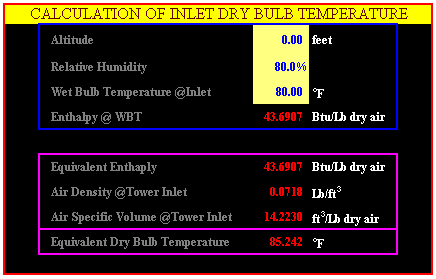|
|
|
|
|
Most of air pressure drops at all the areas excepting fill section can be easily calculated as per the well known formula of K x (Air Velocity / 4008.7)2 x Density Ratio. K is a pressure drop coefficient and depends on the shape of obstruction laid in the air stream. Density ratio is an actual air density divided by 0.075 lb/ft3 @ 70oF dry air conditions. In cooling tower, these pressure losses are called "Static Pressure Loss", just "Static Pressure", or "System Resistance. The performance of cooling tower fans depends on the calculation degree of static pressures at the cooling tower. The minimum value of pressure drop coefficient at the air inlet is including the two turns of air stream directions and is 1.0 for a hypothetical perfect bell inlet. As a guide line, K values at the air inlet are as below; A) Without Louvers
B) With Louvers
In most cases, the pressure drops at the water distribution piping zone are included into the pressure drops at drift eliminators because the drift eliminators are installed onto the water distribution pipes or within 2 feet from pipes. In this case, K values is in the range of 1.6 to 3.0. Of course, it must be based on the data provided by manufacturer. The pressure drop coefficient at the fan inlet will be discussed in the examples related to the fans later again, but it is in the range of 0.1 to 0.3.
Therefore, a constant of 4008.7 is obtained from above in order to convert the unit of pressure drop to inch Aq. using the ft/min unit of air velocity and lb/ft3 unit of air density. It is important to predict the obstructions in the air stream. The obstructions which must be considered in designing the cooling tower are as follows;
The obstructions at the air inlet area are the area of preventing the air flow and are a summation of area projected to the air inlet with the columns, beams, or bracing, etc. There is no need to consider the air flow obstruction due to the inlet louvers. The obstruction at the fill is a plain area which is not filled due to the columns or bracing, etc. The types of air inlet for the counter flow induced draft cooling tower as below are being used.
Example 6-1. Determine the pressure drop at the air inlet for the below given conditions. Given, (Solution) New Tower Range
= Design Range / (1 - % by pass wall water / 100) 1) Water Flow Rate per Nozzle = Design Water Flow Rate / Total Number of Nozzles= 12,500 GPM / 196 = 63.78 GPM/Nozzle 2) By-Pass Wall Water from Spray Nozzles;
3) By-Pass Column Water due to Spray Nozzles near to Tower Internal Columns
Therefore, the actual range through tower is obtained from relation of Design Range / (1 - % By-Pass Water / 100) Actual Range = (104 - 89)
/ (1 - 3.265 / 100) = 15.5063 The air mass is calculated from the relation of G = L / (L/G). Here the value of L is a net water flow rate through the cooling tower. That is, L = Design Water Flow Rate x (500 / 60) x (1 - % By-Pass Water / 100) = 12,500 x (500 / 60) x (1 - 3.265 / 100). (Note: (500 / 60) is a constant to covert water flow rate in GPM to lb/min unit.) Then, the value of air mass flow = 12,500 x (500 / 60) x (1 - 3.265 / 100) / 1.4760 = 68,271.5 lb/min Second, let's calculate the area of obstruction in the air inlet. In case of wood structure, one bay (between center of columns) is based on 6 feet and the traversal member is based on 6 feet in the height. Therefore, the number of bay for the 42 feet of cell length is 7 and the width of column is 4 inch. In the traversal member, two beams are required for this air inlet height. Area of Obstruction due to Columns = No. of Bay x Width of Column x Air Inlet Height x No. of Air Inlet = 7 x (4 / 12) x 15 x 2= 70 ft2 Area of Obstruction due to Traversal Members = No. of Members x Height of Members x Cell Length x No. of Air Inlet = 2 x (4 / 12) x 42 x 2= 56 ft2 Total Area of Obstructions = 70 + 56 = 126 ft2 Overall Area of Air Inlet = Cell Length x Air Inlet Height x No. of Air Inlet = 42 x 15 x 2= 1,260 ft2 % Obstruction @ Air Inlet
= Total Area of Obstructions / Overall Area of Air Inlet
x 100 (%)= 126 / 1,260 x 100(%)= 10.0% |



